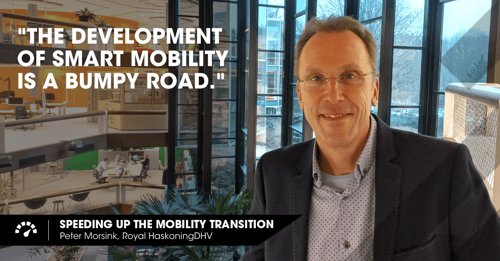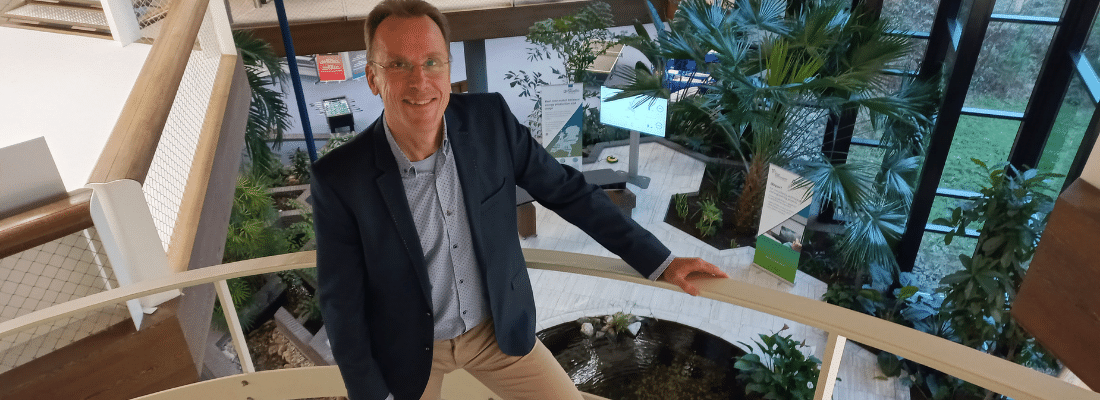Speeding up the mobility transition, Peter Morsink | Royal HaskoningDHV
‘The development of smart mobility is a bumpy road’
With the continuous growth of the population and ongoing urbanization, there are numerous mobility challenges. Sustainability, safety and societal impact are amongst our daily concerns. We need to speed up the mobility transition to keep up with the fast-changing global dynamics, which requires inventive approaches and better solutions. In this series, we share inspiring and innovative cases from all over the world. We spoke to Peter Morsink, Lead Smart Mobility and Road Safety at Royal HaskoningDHV. How does he speed up the mobility transition?
Royal HaskoningDHV is an independent consultancy integrating engineering expertise with digital technologies and software solutions. They design, safeguard, and maintain the built environment - from infrastructure, mobility and buildings to energy, water supplies and industrial sites.
Senior consultant and engineer Peter Morsink focuses on road safety and smart technologies. ‘I advise organisations on putting innovative concepts into practice in order to improve our road safety. For instance, in the deployment of the national Strategic Programme Road Safety in the Netherlands we combine road designs, human behavioural aspects and technological developments. I help road operators to improve road markings and design, by using what is already there, and show what they can do to make their road network future proof. This way we enable them to accelerate the benefits of smart vehicle technology on their roads, and help them to have a good interaction with automotive parties and service providers.’
‘The challenge in my work is to keep the balance between the human, the vehicle and the road.’
‘The challenge in my work is to keep the balance between the human, the vehicle and the road. For that it is important to not push technology too much, but start by better using the existing technology in a smart acceptable way to fulfil the needs and necessary improvements. And at the same time continue to develop new innovative concepts that match societal demands and individual needs.’
‘For example automated driving, one of my main focus areas. We need to make sure that automated driving functions provide the type of support that drivers need and accept to drive safely and comfortably. A prerequisite is that drivers understand how support functions work, and in which road and traffic situations they can or cannot rely on them. Good cooperation in the fields of automotive engineering, driver education, road design and maintenance is needed. We provide necessary insights and tools to make this cooperation work, enabling the promises of smart vehicles to become reality, as one of the pillars on the path towards a safe and sustainable transport system.’
‘The mobility transition is bigger than making vehicles smarter. It is also about behaviour and habits.’
‘To me the mobility transition is bigger than making vehicles smarter. It is also about behaviour and habits. We should start questioning ourselves more often: Do we really need all the trips we make? And if we do travel, do we really need to go by car? Especially in cities, there is a lot to win by motivating people to use other modalities, such as the bicycle and public transport. Still, people want to own a car, due to the sense of freedom it brings when traveling outside the city. If people use a car, let’s use our knowledge to make sure that car trips are as safe and sustainable as possible.’
‘The main challenges in speeding up the mobility transition are:
- Technology has a lot to offer, but it will only work if it takes into the account the pace at which organisations are willing to change and humans accept it. Road operators and road users must understand how it will benefit them, how the technology works, and what is needed on short and longer terms.
- The next step is to further develop the technology and the vehicles.
- Infrastructure, on both the physical and digital site, needs to develop alongside in-car technology. Vehicles with automated driving functions and advanced traffic information services perform best if they are supported by evolving infrastructure, for instance in terms of communications and positioning technology.’
‘We need to work together with the car dealers and manufacturers to help to explain how technology works.’
‘There is a lot to win with education and collaboration. We need to work together with car dealers and manufacturers to help to explain how technology works. This can even enlarge the impact, the potential of the technology. Take technologies such as ADAS systems, like lane-keeping and adaptive cruise control, for example. We need to explain what the purpose is to make sure people are not deterred or experience it as a way of control. By focussing on the positive effects, we can make sure the user accepts it and wants to have it.’
‘Safe and healthy mobility are important in our programmes. We do this by applying a human centric design: making a match between individual and societal needs. What does a person need and what does or does not work properly? If lane-keeping does not work as it should when driving on a certain stretch of road, we inform road operators so they can make improvements where applicable. We also start the dialogue with automotive manufacturers and testing authorities, to put the integrated approach into practice.’
‘It is really important that all parties, both public and private, work together on the same mission.’
‘It is definitely not only the responsibility of the road operator nor the manufacturer. It is really important that all parties, both public and private, work together on the same mission. Coming back to lane-keeping: the road operator needs to make sure that the markings are visible to the car and the manufacturer ensures the system’s hardware and software function in different types of conditions. A continued dialogue is needed to make sure that both parties understand each other well and come to good workable standards.’

We advise governments and road authorities on how to use new technology, smart vehicles and Artificial Intelligence locally to improve road safety. For example, we have developed an assessment tool with road authorities to see how well ADAS systems function, focussed on the lay out of the road. In another project we investigated various road situations that ADAS encounter. What can you do to adapt physical and digital infrastructure and have a more positive effect from ADAS systems?’
‘People overestimate and underestimate what systems can do. We need to work on that!’
‘Let’s not forget the main subject, our user. People overestimate and underestimate what systems can do. We need to work on that! We conduct user surveys to determine the needs of road users, their knowledge of ADAS systems and their expectations. In the Netherlands we also involve CBR, Dutch institution for driving exams, to explain systems during driving lessons.’
‘With respect to another important topic in the mobility transition, electrification of the vehicle fleet, we also help road authorities to optimize the strategy for installing charging stations. However, to stimulate electric driving, we have to show that electric driving technology has come a long way. Informing the user and explain how things work, is something very important if we want to motivate people to start driving electrically. One of the reasons for people not to buy an EV is because they think you have to charge every 150 kilometres. But new models can already drive up to 450 kilometres, and even more if you drive slower. We have to note however that current EVs are still quite expensive. Hopefully, as production increases, they will become more affordable.’
‘To optimize the positive effect of the newest technologies, the vision of the private and public parties, and the user have to align.’
‘The biggest challenge, I think, lies in collaboration. In order to optimize the positive effects of the newest technologies, the vision of the private and public parties, and the user have to align. How can we improve the quality of life together by the use of mobility? The development of mobility is a bumpy road. The trick is not to be afraid of that and to keep taking steps. Don't be scared off because you can't see where it's going. We learn by doing.’
‘It is the societal impact that drives me. We work on innovative concepts, which we put into practice and thus contribute to a healthy, liveable and safe society. Together with other stakeholders!’
Share your story
Do you have an innovation, research results or an other interesting topic you would like to share with the professionals in the infrastructure, traffic management, safety, smart mobility and parking industry? The Intertraffic website and social media channels are a great platform to showcase your stories!
Please contact our Sr Brand Marketing Manager Carola Jansen-Young.
Are you an Intertraffic exhibitor?
Make sure you add your latest press releases to your Company Profile in the Exhibitor Portal for free exposure.






